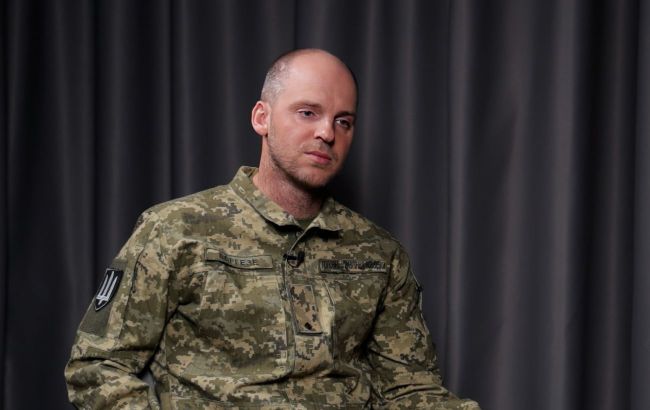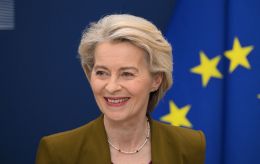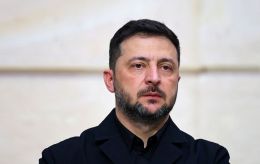'We went to Crimea guided by stars': How Ukraine's intelligence operates behind enemy lines
 Commander of the Brotherhood Ukraine's Defense Intelligence unit Oleksii "Borgese" Serdiuk (Photo by RBC-Ukraine)
Commander of the Brotherhood Ukraine's Defense Intelligence unit Oleksii "Borgese" Serdiuk (Photo by RBC-Ukraine)
Why is the Brotherhood battalion of Ukraine's Defense Intelligence called Christian? What kind of operations do the unit's fighters carry out, and who among recruits is denied entry? Read more about the Brotherhood battalion and daring sabotage missions behind enemy lines in an interview with commander Oleksii "Borgese" Serdiuk.
Among Ukraine's Defense Forces, there is arguably one of the most unusual units - the Brotherhood battalion. Its fighters share a common faith, ideology, and willingness to carry out the most difficult missions deep behind enemy lines. For them, the most important things in battle are not just weapons, but faith, self-discipline, and motivation.
Oleksii "Borgese" Serdiuk, the commander of the Brotherhood battalion of Ukraine's Defense Intelligence, told RBC-Ukraine about daring operations in Crimea, Enerhodar, and enemy rear areas, as well as whether miracles happen in war and the losses among the military elite.
Volunteers, Azov, Ukraine's Defense Intelligence
The story of the Brotherhood began back in 2014, when the first volunteers, most of whom were believers, decided they could not stand aside. At first, they joined official structures, guarding facilities in front-line cities, but they quickly realized this wasn't their path. They wanted more: real frontline work, participation in risky operations, and influence over the course of the war.
"In 2014, we joined as volunteers in many different formations. We were with Azov in Shakhtarsk, and we created our own Saint Mary battalion to defend Mariupol," Borgese recalls.
With the start of the full-scale invasion, the military group came together again - this time with more experience, better equipment, and an even clearer understanding of what they were fighting for. Today, they are a full-fledged battalion specializing in deep raids, reconnaissance, and sabotage behind enemy lines.
"At some point, we were invited to Ukraine's Defense Intelligence, and from there, our path began to rapidly evolve. At first, we were a small group of people within other battalions, within other companies. But then, after earning a certain level of respect, we were able to form our own company. This company became a separate detachment, and now we are building a full battalion," the commander emphasizes.
.jpg)
Christianity - Not just faith, but combat strategy
Christianity is a foundation for every fighter in the Brotherhood. "We have a strict requirement – only Christians: Protestants, Catholics, and Orthodox who share the same moral principles. We've tested this in practice: a unit where everyone believes operates cohesively, is morally resilient, and disciplined," the commander explains, admitting that atheists and representatives of other religions are not accepted into the unit.
In the past, the battalion command could make exceptions for fighters who wanted to join but were not affiliated with the church, but eventually came to the conclusion that shared values are more important than numbers. These shared principles form a strong core of the collective. People of other religions are not accepted into the team because of perceived doctrinal differences.
"People need to have a higher purpose for being here. When they're waiting, when they're bored, when they're scared, when they have to do the impossible - that's when we pray, ask God for help. And everyone knows, they've seen it firsthand, that God gives it to us," says Borgese.
Faith, according to the fighters, becomes their shield and motivation to carry out the most dangerous operations. When things get tough, they find renewed strength through prayer and keep fighting. Oleksii notes that the Brotherhood often works alongside adjacent units. And all fighters observe that their losses are lower than those of their neighbors. Often, they're able to accomplish more than another unit, with more heroic deeds with fewer losses and less risk. Things happen in miraculous ways, says the commander.
"On one street, the enemy dropped so many guided aerial bombs that it looked like the surface of the Moon. On top of that, tanks were driving through and demolishing houses where our guys were hiding in the basements, and the tanks just drove right over them. The enemy was sure no one could have survived," the commander recalls.
During that operation, after intense fighting, the Brotherhood fighters had to retreat, but even during bombing and withdrawal, miraculous events saved their lives.
"When the guys were leaving, the enemy attacked with aviation and drones. That was the first time we used electronic warfare. But every soldier knows - it's not guaranteed to jam a drone, since they use different frequencies, it's just logical. But here, drones were dropping like flies, missiles from planes, guided aerial bombs… And not a single fighter was killed, not even wounded. It was incredible," Serdiuk says.

Operation in Crimea: Night, fog, and prayer
One of the riskiest and most mystic operations was the landing on temporarily occupied Crimean territory. The mission was clear: strike the enemy's radar hub on the coastline. But the path was far from simple - over 100 km of open sea.
"It's very important that the fighters are capable of carrying out a given task. The fighters I have, these were the ones who could do it. That's the main and honestly the hardest thing when it comes to combat tasks - being certain that your people can do it," the commander explains.
Borgese notes that a common mistake is when commanders plan missions based only on theoretical knowledge, without understanding whether the team can really do it. At sea, each fighter is on their own, and any obstacle can derail the mission. Only the desire to achieve the goal makes the difference. And that night, there were many obstacles.
"When we went out to sea, navigation failed, GPS wasn't working. It was complete radio silence. We followed the stars. One of the boat engines broke down, and we had to coordinate with hand signals. There were moments when it felt like the mission would fail," Serdiuk recalls.
Despite the equipment issues, the fighters successfully landed on the peninsula's coast and destroyed the radar station. The withdrawal was tough, but once again, prayer came to the rescue.
"When the fighters were escaping and enemy ships were closing in, a fog appeared. And when they got far enough away, the signal returned, GPS started working. The fog lifted, the sky was clear, the sun rose, the sea was calm. And just as they reached shore, a massive thunderstorm hit. I looked at all of it and thought: God, what a miracle. They had just landed, barely an hour passed. I mean - these are miracles!" the Ukrainian military says confidently.
According to the commander, landings like the one in occupied Crimea are highly demonstrative and have a psychological impact. They boost morale for Ukrainians and demoralize the enemy. "After we operated there, the enemy began deploying significant forces to defend their coastline," Borgese explains.
.jpg)
'Suicide squad'
The commander jokes that their unit is a "suicide squad," called upon for the toughest missions. Deep raids into enemy rear, sabotage 70 km past the front line, reconnaissance of targets in occupied territories - this is their bread and butter.
"I once joked that we're lile in the Suicide Squad movie. Where they gather all these extraordinary people to complete the most difficult tasks. That's what our unit reminds me of. And we're assigned the hardest tasks - the ones that require creativity," Borgese says.
The commander shares that the Brotherhood has carried out numerous sabotage missions deep behind enemy lines, where each operation needed meticulous planning - you can't just count on luck.
"When we landed near Enerhodar, we saw Russian observation posts where their machine gunners were stationed. It was impossible to sneak up - they had a lot of people. But at that moment, they were asleep. If they had woken up - we'd all be dead. But miracles happen, and they happen regularly. Still, you can't always count on miracles," the commander believes.
Pokrovsk, frontline, destroyed enemies
Fighters of the Brotherhood Battalion also fought near Kupiansk, Enerhodar, and in the Kursk region. The defense of Pokrovsk was a true trial for them. It was one of the hottest sections of the front - the enemy deployed equipment, infantry, and drones. At one point, the frontline was "breathing" beneath their feet - the enemy pushed day and night.
"We took over a sector - about three kilometers of front. There were fewer of us, but we held it. We worked preemptively - destroying their observation posts, drone pilots, even field artillery," Serdiuk recalls.
While stationed at one of the hottest points on the front, they and adjacent units had to repel daily fierce attacks by Russian forces. Every night started with recon, every morning with strikes. It was a sleepless war. But they managed to hold the line and push back enemy forces.
"In Pokrovsk, the defensive lines were excellent. So good that while we were there, we felt very confident. They had very solid trenches, strong bunkers, strong pillboxes," the Ukrainian military notes.
But there’ is often a problem with manpower to hold such a line. "A clear example is the Kupiansk direction, where I saw for the first time how the Russians were really just sending in hundreds after hundreds. In two months, on the section we controlled, about 2-3 kilometers, I believe around a thousand Russians were killed. And that's not an exaggeration. Why do I say that? Because when I used to hear reports about enemy losses, I thought the numbers were inflated. But there, I saw for myself and it's true. I saw them dying every day," Serdiuk shares.
After several months of defense, over a thousand enemy soldiers were killed, while losses among Ukraine's Defense Forces were significantly lower. Of all the units holding that line, 30 defenders died. This shows that the enemy’s tactics are ineffective, and that often a smaller, more capable force can be dominant in battle.

